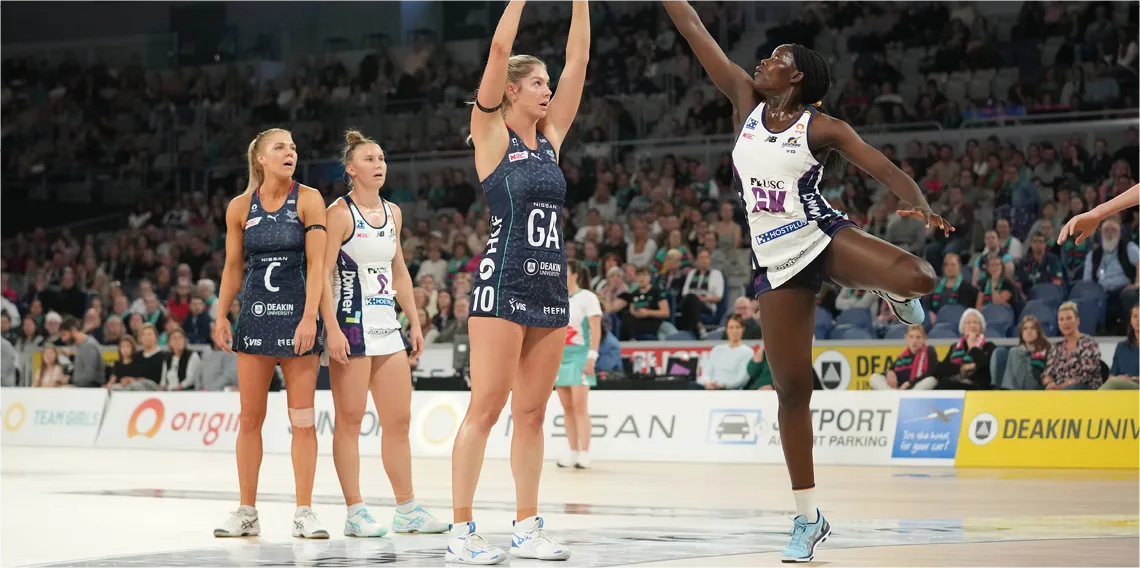A deep dive into the progression of the Suncorp Super Shot

Since 2020, to the chagrin of many, there have been two versions of netball. 1. The elite Australian domestic kind. 2. What’s played everywhere else.
Which brings us to the Super Shot. Of course it does, for the two-pointer remains, late in season two, a vexed issue for both fans and competitors. Yet although it appears that Suncorp Super Netball’s controversial scoring system is a little less friendless than it was, social media is not the only place where opposition remains.
“I guess I was a pretty strong opponent to begin with, and obviously we’ve been losing this year, so it has come in somewhat useful when you’re trying to chase down a lead,’’ says Melbourne Vixens and Australian Netball Players’ Association president Jo Weston, also a member of the Diamonds’ squad for the four-Test Constellation Cup series against New Zealand starting in Brisbane on 13 October.
“But I’m probably more of a traditionalist when it comes to at least the scoring side of the game. So, I think it’s good that the international rules have stayed somewhat consistent over the last few years rather than bending to what has probably been deemed a little bit of a gimmick.’’
Weston agrees that the bigger issue, soon enough, will be the multiple adjustments required when moving from one form of the game to the other, noting that the Super Shot is a factor for just the last five minutes of every quarter, or one-third of total game time.
Neither time outs nor the rolling substitutions that have been widely welcomed - not least because they dispense with the faux ‘injuries’ that enable interchanges - have been adopted internationally, where varying umpiring interpretations of, particularly, the contact rule, have long been another source of Australian frustration.
“We’re used to being able to change momentum by calling a tactical time out and being able to receive coaching instruction and just take a little bit of a breather, but in the international game you don’t have that opportunity,’’ Weston says.
“So it definitely means that you have to have a pretty clear strategy out on court and also a few plans up your sleeve if things aren’t going according to Plan A.’’
And physiologically?
“You definitely have to have a really high level of fitness to be able to play out 15-minute quarters, and four of them - especially if you’re not in the book-end positions at each end of the court. But we know that coming in, so our training is tailored accordingly,’’ she adds.
“And it’s just about having different defensive strategies, that if we need to be able to change it up to alleviate some of that physical pressure that’s on athletes on court, we can do that and still be effective in what we want to achieve.’’
As to what’s ideal, Weston will not miss the sound of the five-minute hooter and instant need to adjust defensively for the Super Shot, and would support a combined model that includes unlimited rolling subs but perhaps one time out per coach per half rather than SSN’s maximum of two.
“So I think, yes, a little hybrid,’’ she says. “But the international level’s very traditional and I guess it’s not as progressive as Suncorp Super Netball, as it doesn’t probably have the commercial pressures that our domestic league has in terms of trying to generate extra revenue and draw in extra eyeballs to watch the game, so I guess it’s up to them to decide what they’re thinking about it.’’
That includes ‘rolling subs’ by another name (ie. ‘injury’ timeouts), which were frequent in the previous Constellation Cup series played in New Zealand in March.
“It’s ‘oh, I’ve hurt my finger’ to the umpires, but then be eligible to back out on court in the next five minutes, so it is a little bit silly,’’ says Weston. “I don’t know if we’ll see that change just yet, but there’s definitely room for it, I think, in the international game.’’
Dr Aaron Fox, a Deakin University lecturer in Applied Sports Science, says the inability to inject breaks and make regular substitutions during quarters represents a significant difference when shifting from SSN (28 regular season games per team plus finals and Tests (four in total involving the Diamonds) so far in 2020-21, although the exact impact on player rest - and potentially, injuries - is difficult to quantify.
“The players have the capacity to run out international games; it’s not something they haven’t done, but it’s probably something they haven’t done as regularly as the SSN games the last two years – and there's different physical demands on the players during those games given the different rules,’’ he says.
“So you’d definitely expect them to fatigue more, but there’s a bit of conflicting evidence out there as to how that impacts things like injury. There’s one side of the argument that players start getting more fatigued and that could open them up to more injuries, but also that players are getting more fatigued so the game potentially slows down, which can reduce the risk of injury.
“I think that’s the idea the AFL takes with their interchange caps, which they’ve tried to implement from a protective perspective of slowing the game down.’’
What we do know is just how much ground netballers cover on a court that measures just 30.5 metres long and 15.25 metres wide. Deakin University research (Brooks et al, 2000) published in the Journal of Sports Sciences shows that centres, as you’d expect, run the furthest: a mean distance of almost 5.5km per game.
Even goal shooters, who consistently move the least, averaged over 2km and - along with goal keepers - changed direction the most, relative to distance covered in their third-of-the-court confines.
The Super Shot, in contrast, is more of a mental burden/consideration - at least for some. At the end of its debut season, a Deakin survey found that even with the focus more obviously on the shooters whose job it was to score from longer range, it was the defenders who felt the greatest impact on their gameplay.
While less than 20 per cent of players supported the two-pointer’s retention for 2021, Fox noted a softening of the initial negativity by the end of 2020. He also predicted that reverting to the traditional scoring system would potentially be a positive for the Diamonds during the Constellation Cup – due to one fewer strategic aspect to worry about - even if it may also involve a shift in how lead sizes are perceived without a mechanism to accelerate closing them.
“It might take an extra thing that they had in SSN out of their mind,’’ says Fox. “They don’t need to think about making that adjustment to the Super Shot because it’s never coming in the international game. So that could be a bit of a relief.’’
Written by Linda Pearce
More news
My items
You have not looked at any packages recently.
There are no featured packages.



